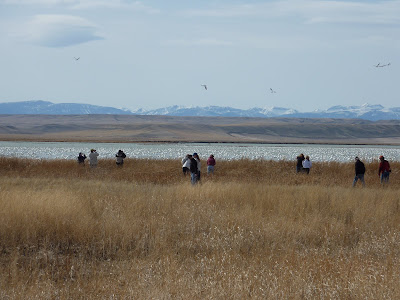It didn't take long for other changes to strike me. On my drive up to the study area, several bighorn sheep crossed the road in front of me at one point. In the more than 200+ trips I had made into this area in the late 1960's, bighorns were never seen. They are a new and welcome addition. As I ascended the steep, narrow gravel road up to the study area, there were some rather obvious changes in the vegetation, with the young conifer thickets that were the center of grouse breeding territories noticeably different. Some of this change was due to increasing age, and some was due to an ill-advised thinning project implemented by the Forest Service a number of years ago.
 These changes left me somewhat concerned that some of the area might no longer be suitable for breeding blue/dusky grouse. But my fears were soon allayed. I stopped several times to listen for the distinctive "hooting" and wing clap sounds that signal the presence of these mountain grouse. And it wasn't long before I followed these sounds to my first displaying male grouse. It was in the same area where I had located a breeding territory 43 years previously.
These changes left me somewhat concerned that some of the area might no longer be suitable for breeding blue/dusky grouse. But my fears were soon allayed. I stopped several times to listen for the distinctive "hooting" and wing clap sounds that signal the presence of these mountain grouse. And it wasn't long before I followed these sounds to my first displaying male grouse. It was in the same area where I had located a breeding territory 43 years previously.Dusky grouse, like people and other animals , seem to have differing personalities. Some are brazen and outgoing, and others are somewhat retiring and shy. My first male of the day was of the latter persuasion, so my attempts at good photo images were not very successful. This male was a little less shy but still not very cooperative.
 But later that morning, I was fortunate to find a more accommodating male, albeit one whose tail was just regrowing, perhaps after a lucky escape from a predator of some sort. Here is the more friendly fellow with the stubby tail!
But later that morning, I was fortunate to find a more accommodating male, albeit one whose tail was just regrowing, perhaps after a lucky escape from a predator of some sort. Here is the more friendly fellow with the stubby tail!  Males would often flush into a nearby tree where they were often very difficult to spot and get pictures of. But occasionally, they posed in the open.
Males would often flush into a nearby tree where they were often very difficult to spot and get pictures of. But occasionally, they posed in the open.  When I was working in this area in the 1960's, my data indicated that the peak of the breeding season for these grouse was about May 7-10 or so. This year, I was about 2 weeks earlier than that, but there seemed to be plenty of activity, and some females were found throughout each morning. This one posed nicely for me along the side of the road.
When I was working in this area in the 1960's, my data indicated that the peak of the breeding season for these grouse was about May 7-10 or so. This year, I was about 2 weeks earlier than that, but there seemed to be plenty of activity, and some females were found throughout each morning. This one posed nicely for me along the side of the road.  At one of my initial listening stops, the sound of a new, bonus bird was heard, a gobbling wild turkey tom! This was certainly unexpected, but perhaps not unusual in this scattered Ponderosa Pine habitat which is typical of where this species is often found in Montana. On my trip into the area on the second morning, I was rewarded with a tom turkey displaying for several nearby hens.
At one of my initial listening stops, the sound of a new, bonus bird was heard, a gobbling wild turkey tom! This was certainly unexpected, but perhaps not unusual in this scattered Ponderosa Pine habitat which is typical of where this species is often found in Montana. On my trip into the area on the second morning, I was rewarded with a tom turkey displaying for several nearby hens. 
 It was comforting for me to know that these grouse that I had worked with and come to know over a 3-year period were still easily found in many of the same places. Were they as abundant as they were 40+ years ago? That is a question that cannot be reasonably answered in such a short visit. But my curiosity about their presence was resolved and the reminiscing I enjoyed made for a very fulfilling experience on this Return to the Bitterroot Blues!
It was comforting for me to know that these grouse that I had worked with and come to know over a 3-year period were still easily found in many of the same places. Were they as abundant as they were 40+ years ago? That is a question that cannot be reasonably answered in such a short visit. But my curiosity about their presence was resolved and the reminiscing I enjoyed made for a very fulfilling experience on this Return to the Bitterroot Blues!




















